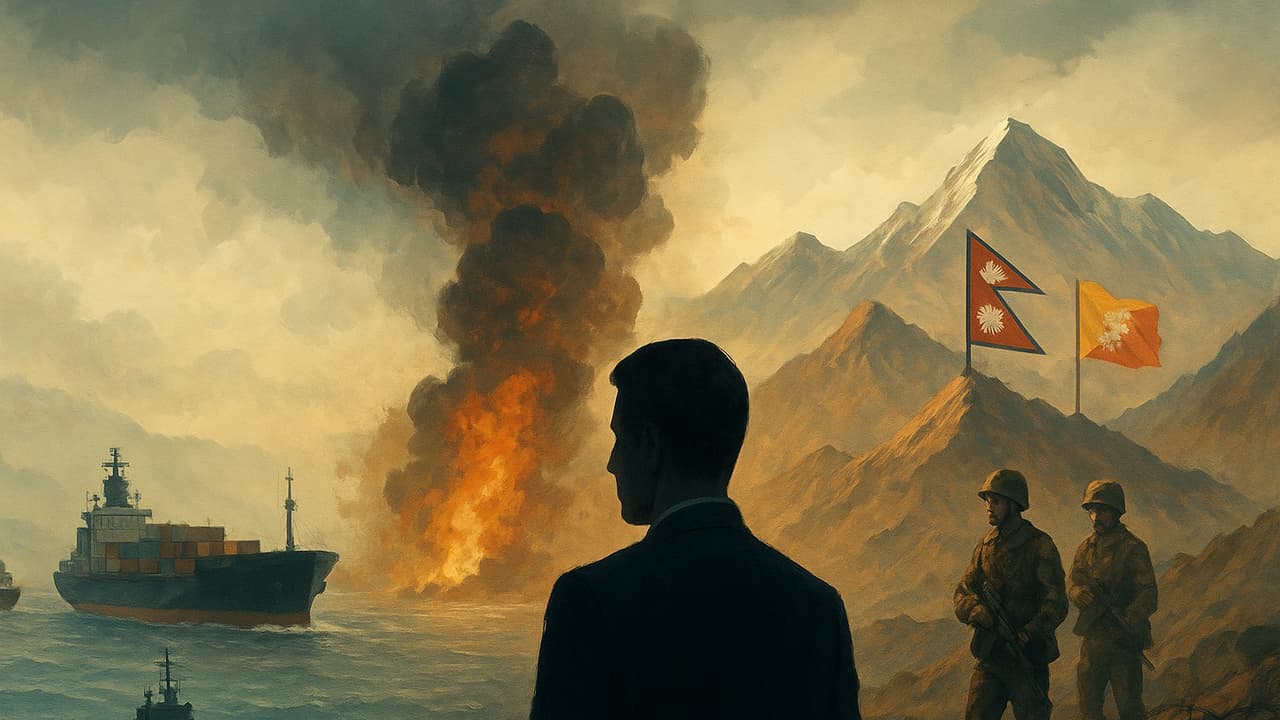How global powers use instability as leverage — from the Indo-Pacific to the Himalayas, small crises often justify bigger interventions, foreign bases, and external control. When chaos rises, influence follows.
New Delhi: On a foggy morning in the Strait of Malacca, a small disruption – a tanker stalled in a narrow lane – forces ships to slow, reroute, and call their insurers. Within hours, headlines talk of ‘risk’ and ‘security’. Naval patrols step up. New exercises are announced. A minor incident becomes a reason to expand presence, rewrite rules and claim the role of ‘stability provider’. This is how small shocks can scale into strategic leverage.
The Indo-Pacific lens
The US views the Indo-Pacific as the world’s main arena – big economies, busy sea routes, and rising military competition. From this lens, the Himalayan arc – Nepal, Bhutan, and the India-China frontier – sits beside key pressure points.
If the mountains stay calm, trade and diplomacy have room. If they ripple, every actor outside the region gains arguments for deeper involvement. More training missions, more aid with strings and more say in how states manage borders and budgets.
Southeast Asia’s waters carry much of the world’s oil, gas, and goods. Any hint of piracy, grey-zone tactics, or local tension quickly justifies larger patrols and joint drills. The reason for this is that where trade is fragile, a navy can claim it is essential. This cycle can be healthy when it prevents real conflict.
But it can also become a habit. Each flare-up invites new deployments, each deployment becomes the new normal. Over time, states learn to live with constant “exercises,” visiting forces, and rules written far away.
Analysts who study power politics often describe a pattern. Some big powers do not always seek outright war. Instead, they tolerate or manage a level of instability that keeps local governments dependent. The message is subtle—“we can help you if you align with our plan.” Budgets, loans, and security training are presented as solutions, but they can also create reliance. When the pressure rises, so does leverage.
Iraq and Libya began as promises of quick fixes and safer futures. Both ended with long periods of turmoil that pulled in foreign militaries, contractors, and outside agendas for years.
Ukraine, on the other hand, shows the other side. A country under assault that now depends on external support to survive. Aid and weapons have saved lives, but they also knit Kyiv’s decisions into a wider geopolitical framework.
These cases differ in cause and justice. The common thread is this – once crisis begins, outsiders gain influence over timing, money and choices. Stability returns slowly, and often on terms set by whoever holds the purse and the power.
The Himalayan balance
In the mountains, India’s Army has long acted as a stabilizing weight – maintaining patrols, building roads and helipads, supporting local communities near the border, and keeping channels open to avoid miscalculation.
For Nepal and Bhutan, that steadiness matters. When posts are manned, communications work, and joint drills with neighbours stay transparent, space for outside manipulation shrinks. Calm borders reduce the excuses for third-party ‘help’ that arrives with conditions.
A flare-up becomes a headline that justifies bigger bases and longer missions, markets panic and credit tightens so states seek loans that come with policy conditions, crisis talk lets whoever sets the narrative pose as the problem-solver and sway local decisions, and training, equipment, and advisers lock in standards, suppliers, and habits that create lasting dependence.
The US angle – benefits and risks
Washington argues that presence deters aggression and protects trade. There is truth in that – deterrence has value. Yet critics point out that a system built on constant “near-crisis” also serves US goals – it keeps partners aligned, justifies budgets, and frames America as the default security manager.
The risk for small states is that they inherit the costs of a great-power contest they did not choose higher insurance, politicized aid and crowded skies and seas.
Not every crisis is engineered, and not every patrol is a plot. But the pattern deserves plain words – instability. Whether sudden or managed. It opens doors for external agendas.
In the Indo-Pacific and the Himalaya, this often means more presence, more programmes and more pressure to align. The antidote is boring but powerful – steady institutions, quiet borders, transparent finance, and regional habits of cooperation.
When the region can prevent small shocks from becoming grand dramas, it keeps agency. And when agency stays local, leverage from afar loses its grip.
